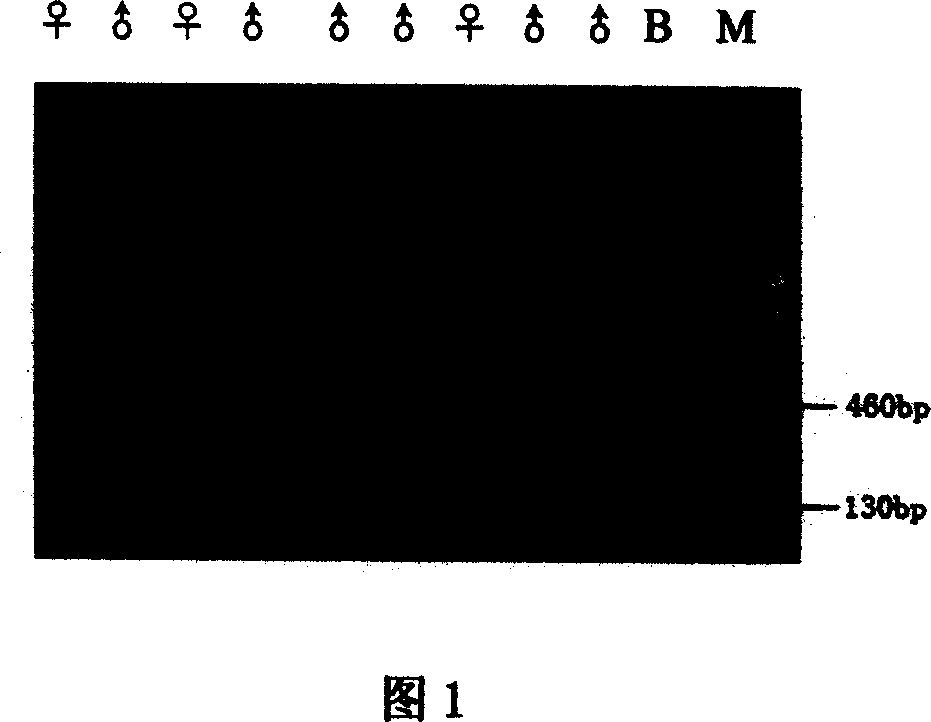Method of identifying buffalo embryo sex using nest-type PRC
A technology of embryos and buffaloes, applied in the field of bioengineering, can solve the problems of not being able to satisfy the market, and achieve the effects of accelerating breeding speed, improving quality, and reducing pollution rate
- Summary
- Abstract
- Description
- Claims
- Application Information
AI Technical Summary
Benefits of technology
Problems solved by technology
Method used
Image
Examples
Embodiment 1
[0024] Example 1: The specificity of the primers was detected by performing sex identification on genomic DNA of buffalo with known sex.
[0025] (1) get fresh buffalo blood, extract DNA with phenolic extraction method;
[0026] (2) Add 2.5 μL of PCR buffer, 0.5 μL of dNTP (50 μM), upstream and downstream external primers and upstream and downstream internal reference primers GAPDH (50 pM each), 200 ng of genomic DNA, 2U TaqDNA polymerase, and deionized water into a new EP tube to a total reaction volume of 25 μL. Pre-melt in a PCR instrument at 94°C for 2min, then perform the following 20 cycles: 95°C for 20s; 62°C for 30s; 72°C for 30s, and finally 72°C for 5min to stop the reaction;
[0027] (3) Take out 0.5 μL of the above PCR product and add it to a new PCR tube, then add 2.5 μL of PCR buffer, 0.5 μL of dNTP (50 μM), upstream and downstream internal primers and upstream and downstream internal reference primers GAPDH (each 50 pM), 2U Taq DNA polymerization For enzyme, a...
Embodiment 2
[0029] Embodiment 2: Buffalo embryo gender identification
[0030](1) Use a micromanipulator or a microneedle to obtain a small amount of embryo samples from a small portion of the blastocyst excised embryo. Embryos after sampling were cryopreserved and stored in liquid nitrogen tanks.
[0031] (2) The embryo samples obtained above were washed three times in calcium and magnesium-free PBS (phosphate buffered solution), put into PCR tubes respectively, added 10 μL of cell lysate (Lysis Solution), left at room temperature for 5 minutes, and incubated at 98°C for 10 minutes To inactivate proteinase K, the treated sample is directly used as template for PCR reaction.
[0032] (3) Add 23 μL of PCR Mix solution (including PCR buffer, dNTP, Taq enzyme, deionized water), upstream and downstream external primers and upstream and downstream internal reference primers (each 50 pM) into a new PCR tube, and the total reaction volume is 25 μL. Pre-melt at 94°C for 2min in a PCR machine, a...
PUM
 Login to View More
Login to View More Abstract
Description
Claims
Application Information
 Login to View More
Login to View More - R&D
- Intellectual Property
- Life Sciences
- Materials
- Tech Scout
- Unparalleled Data Quality
- Higher Quality Content
- 60% Fewer Hallucinations
Browse by: Latest US Patents, China's latest patents, Technical Efficacy Thesaurus, Application Domain, Technology Topic, Popular Technical Reports.
© 2025 PatSnap. All rights reserved.Legal|Privacy policy|Modern Slavery Act Transparency Statement|Sitemap|About US| Contact US: help@patsnap.com


